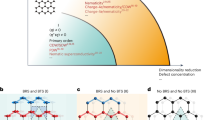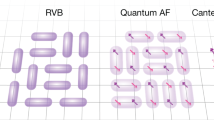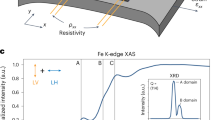Abstract
Electronic nematicity is a state of matter in which rotational symmetry is spontaneously broken and translational symmetry is preserved. In strongly correlated materials, nematicity often emerges from fluctuations of a multicomponent primary order, such as spin or charge density waves, and is termed vestigial nematicity. One widely studied example is Ising nematicity, which arises as a vestigial order of collinear antiferromagnetism in the tetragonal iron pnictide superconductors. Because nematic directors in crystals are restricted by the underlying crystal symmetry, recently identified quantum materials with three-fold rotational symmetry offer a new platform to investigate nematic order with three-state Potts character. Here we demonstrate strain control of three-state Potts nematicity as a vestigial order of zigzag antiferromagnetism in FePSe3. Optical linear dichroism measurements reveal the nematic state and demonstrate the rotation of the nematic director by uniaxial strain. We show that the nature of the nematic phase transition can also be controlled by strain, inducing a smooth crossover transition between a Potts nematic transition and an Ising nematic flop transition. Elastocaloric measurements demonstrate the signatures of two coupled phase transitions, indicating that the vestigial nematic transition is separated from the antiferromagnetic transition. This establishes FePSe3 as a system to explore three-state Potts vestigial nematicity.
This is a preview of subscription content, access via your institution
Access options
Access Nature and 54 other Nature Portfolio journals
Get Nature+, our best-value online-access subscription
$32.99 / 30 days
cancel any time
Subscribe to this journal
Receive 12 print issues and online access
$259.00 per year
only $21.58 per issue
Buy this article
- Purchase on SpringerLink
- Instant access to full article PDF
Prices may be subject to local taxes which are calculated during checkout





Similar content being viewed by others
Data availability
The datasets generated during and/or analysed during this study are available from the corresponding authors upon reasonable request. Source data are provided with this paper.
References
Norman, M. R. The challenge of unconventional superconductivity. Science 332, 196–200 (2011).
Monthoux, P., Pines, D. & Lonzarich, G. Superconductivity without phonons. Nature 450, 1177–1183 (2007).
Malinowski, P. et al. Suppression of superconductivity by anisotropic strain near a nematic quantum critical point. Nat. Phys. 16, 1189–1193 (2020).
Rubio-Verdú, C. et al. Moiré nematic phase in twisted double bilayer graphene. Nat. Phys. 18, 196–202 (2022).
Chichinadze, D. V., Classen, L. & Chubukov, A. V. Nematic superconductivity in twisted bilayer graphene. Phys. Rev. B 101, 224513 (2020).
Choi, Y. et al. Electronic correlations in twisted bilayer graphene near the magic angle. Nat. Phys. 15, 1174–1180 (2019).
Jiang, Y. et al. Charge order and broken rotational symmetry in magic-angle twisted bilayer graphene. Nature 573, 91–95 (2019).
Nie, L. et al. Charge-density-wave-driven electronic nematicity in a kagome superconductor. Nature 604, 59–64 (2022).
Xu, Y. et al. Three-state nematicity and magneto-optical Kerr effect in the charge density waves in kagome superconductors. Nat. Phys. 18, 1470–1475 (2022).
Jiang, Z. et al. Observation of electronic nematicity driven by the three-dimensional charge density wave in kagome lattice KV3Sb5. Nano Lett. 23, 5625–5633 (2023).
Wu, P. et al. Unidirectional electron–phonon coupling in the nematic state of a kagome superconductor. Nat. Phys. 19, 1143–1149 (2023).
Fernandes, R. M. & Venderbos, J. W. Nematicity with a twist: rotational symmetry breaking in a moiré superlattice. Sci. Adv. 6, eaba8834 (2020).
Little, A. et al. Three-state nematicity in the triangular lattice antiferromagnet Fe1/3NbS2. Nat. Mater. 19, 1062–1067 (2020).
Zhang, H. et al. Cavity-enhanced linear dichroism in a van der Waals antiferromagnet. Nat. Photon. 16, 311–317 (2022).
Cui, J. et al. Chirality selective magnon-phonon hybridization and magnon-induced chiral phonons in a layered zigzag antiferromagnet. Nat. Commun. 14, 3396 (2023).
Haglund, A. Thermal conductivity of MXY3 magnetic layered trichalcogenides. PhD dissertation, Univ. of Tennessee (2019).
Ni, Z. et al. Signatures of Z3 vestigial Potts-nematic order in van der Waals antiferromagnets. Preprint at https://arxiv.org/abs/2308.07249 (2023).
Fernandes, R. M., Orth, P. P. & Schmalian, J. Intertwined vestigial order in quantum materials: nematicity and beyond. Annu. Rev. Condens. Matter Phys. 10, 133–154 (2019).
Fernandes, R., Chubukov, A. & Schmalian, J. What drives nematic order in iron-based superconductors? Nat. Phys. 10, 97–104 (2014).
Zhang, Q. et al. Observation of giant optical linear dichroism in a zigzag antiferromagnet FePS3. Nano Lett. 21, 6938–6945 (2021).
Hwangbo, K. et al. Highly anisotropic excitons and multiple phonon bound states in a van der Waals antiferromagnetic insulator. Nat. Nanotechnol. 16, 655–660 (2021).
Zhang, X.-X. et al. Spin dynamics slowdown near the antiferromagnetic critical point in atomically thin FePS3. Nano Lett. 21, 5045–5052 (2021).
Ni, Z. et al. Imaging the Néel vector switching in the monolayer antiferromagnet MnPSe3 with strain-controlled Ising order. Nat. Nanotechnol. 16, 782–787 (2021).
Ni, Z. et al. Direct imaging of antiferromagnetic domains and anomalous layer-dependent mirror symmetry breaking in atomically thin MnPS3. Phys. Rev. Lett. 127, 187201 (2021).
Chu, H. et al. Linear magnetoelectric phase in ultrathin MnPS3 probed by optical second harmonic generation. Phys. Rev. Lett. 124, 027601 (2020).
Schäfer, F. & Kleemann, W. High-precision refractive index measurements revealing order parameter fluctuations in KMnF3 and NiO. J. Appl. Phys. 57, 2606–2612 (1985).
Gehring, G. On the observation of critical indices of primary and secondary order parameters using birefringence. J. Phys. C 10, 531 (1977).
Ferré, J. & Gehring, G. Linear optical birefringence of magnetic crystals. Rep. Prog. Phys. 47, 513 (1984).
Wiedenmann, A., Rossat-Mignod, J., Louisy, A., Brec, R. & Rouxel, J. Neutron diffraction study of the layered compounds MnPSe3 and FePSe3. Solid State Commun. 40, 1067–1072 (1981).
Cenker, J. et al. Reversible strain-induced magnetic phase transition in a van der Waals magnet. Nat. Nanotechnol. 17, 256–261 (2022).
Chu, J.-H., Kuo, H.-H., Analytis, J. G. & Fisher, I. R. Divergent nematic susceptibility in an iron arsenide superconductor. Science 337, 710–712 (2012).
Ikeda, M. S. et al. AC elastocaloric effect as a probe for thermodynamic signatures of continuous phase transitions. Rev. Sci. Instrum. 90, 083902 (2019).
Ikeda, M. S. et al. Elastocaloric signature of nematic fluctuations. Proc. Natl Acad. Sci. USA 118, e2105911118 (2021).
Wang, Y. et al. Emergent superconductivity in an iron-based honeycomb lattice initiated by pressure-driven spin-crossover. Nat. Commun. 9, 1914 (2018).
Bhutani, A., Zuo, J. L., McAuliffe, R. D., dela Cruz, C. R. & Shoemaker, D. P. Strong anisotropy in the mixed antiferromagnetic system Mn1–xFexPSe3. Phys. Rev. Mater. 4, 034411 (2020).
Guo, Y. et al. Distinctive in-plane cleavage behaviors of two-dimensional layered materials. ACS Nano 10, 8980–8988 (2016).
Acknowledgements
We thank Q. Zhang for substantial insights. This work was mainly supported by the Department of Energy, Basic Energy Sciences, Materials Sciences and Engineering Division (DE-SC0012509). Strain devices were partially supported by the Air Force Office of Scientific Research (AFOSR) Multidisciplinary University Research Initiative (MURI) program, grant no. FA9550-19-1-0390. Bulk crystal growth and EC measurements were supported by NSF MRSEC DMR-2308979 and the Gordon and Betty Moore Foundation’s EPiQS Initiative, grant no. GBMF6759 (to J.-H.C.). We also acknowledge the use of facilities and instrumentation supported by NSF MRSEC DMR-1719797. X.X. and J.-H.C. acknowledge support from the State of Washington-funded Clean Energy Institute.
Author information
Authors and Affiliations
Contributions
X.X., K.H., J.-H.C., H.W. and E.R. conceived the experiment. K.H. fabricated the samples and performed the optical measurements. J.C. designed and built the strain cell for atomically thin flakes. E.R. performed the EC measurement, and Q.J. synthesized and characterized the bulk crystals under the supervision of J.-H.C. D.X. constructed the domain population model. All authors contributed to the data analysis and interpretation. K.H., X.X., E.R. and J.-H.C. wrote the paper with input from all authors. All authors discussed the results and commented on the paper.
Corresponding authors
Ethics declarations
Competing interests
The authors declare no competing interests.
Peer review
Peer review information
Nature Physics thanks Deep Jariwala, Gediminas Simutis and the other, anonymous, reviewer(s) for their contribution to the peer review of this work.
Additional information
Publisher’s note Springer Nature remains neutral with regard to jurisdictional claims in published maps and institutional affiliations.
Extended data
Extended Data Fig. 1 Linear dichroism spectrum.
Linear dichroism signal as a function of incident photon energy for a thin-bulk FePSe3 sample at 5 K. The spectrum shows a broad LD response centered around 2 eV. The photon energy dependent LD response is possibly due to a resonance effect with a d-d electronic transition. Previous measurements on FePS3 showed similar enhancement of LD response at known d-d transitions.
Extended Data Fig. 2 Strain apparatus and crystal response to strain.
Schematic of the strain cell used for the strain measurements and optical image of a representative strain sample. The crystal zigzag direction was aligned along the strain direction.
Extended Data Fig. 3 Strain calibration using Si phonon mode and Thermal calibration.
a, Raman spectra of the silicon Raman mode centered around 525 cm−1 with −80 V (blue) and 80 V (red) applied to the strain cell. b, Raman shift of the silicon Raman mode as a function of the piezo voltage. c, Linear dichroism versus temperature for a non-strained, thin bulk FePSe3 flake on the strainer setup, showing the shift (~10 K) in the transition temperature due to the increased thermal load of the strainer. The x-axis shows the nominal thermocouple reading.
Extended Data Fig. 4 Linear dichroism spatial mapping.
a, Nematic directors (represented by the white arrows) at each sampled point overlaid on top of the reflection raster map for various piezo voltages. The raster map was scanned over 28 μm × 14 μm area with 1 μm step sizes. The maximally negative voltage corresponds to the highest compressive strain applied. Scale bar: 5 μm. The absence of distinct nematic domains, which are separated by 2π/3, across the sample demonstrates that the results of Fig. 2a, b are not a product of our probe beam concomitantly sampling adjacent nematic domains. b, Optical image of the measured strain sample. The red box represents the area which the LD mapping was measured, and the black arrow shows the strain direction. Scale bar: 5 μm.
Extended Data Fig. 5 Polarization-resolved Raman spectroscopy of the strain FePSe3 sample.
a, Raman response of a thin-bulk flake at two thermal points. Labelled peaks (P1, P2, and P3) correspond to Raman modes associated with the zigzag AFM order. b, c, Co-linearly polarized Raman scattering as the incident polarization is rotated for compressive (−120 V) and tensile (90 V) strain, respectively. d, e, Polar plot of the integrated intensity of the Raman mode labelled P1 superimposed onto zigzag orders at compressive (d) and tensile (e) strain. P1 Raman mode exhibits a four-fold symmetry that is rotationally separated by π/4 with respect to the zigzag order. Thus, a 2π/3-shift in the zigzag order would result in a π/6-shift in the incident polarization dependence of the Raman mode.
Extended Data Fig. 6 Polarization-dependent intensity of Raman mode at ~73 cm−1.
a, Polarization dependence of the integrated intensity of Raman mode labelled P1 in Extended Data Fig. 5 as strain is swept from compressive (blue curves) to tensile (red curves) side. b, Incident polarization angle values where the Raman peak reaches the maximum value. There is near 30-degree rotation as strain is swept from compressive to tensile strain.
Extended Data Fig. 7 Raw data and background subtraction.
a,b, Polarization-dependent LD responses at 35 K and 160 K, respectively. The black curves represent the background LD response from the sample at 295 K. The pink curves represent the raw LD response observed from the sample. The blue curves are the LD response after subtracting the background response from the raw data.
Extended Data Fig. 8 Domain Population Model Fitting.
a, Polarization-dependent LD response shown in Fig. 2a. b,c, LD responses and corresponding fit to function, \(LD(\theta )=f(\varepsilon )\,\cos (2\theta )+[1-f(\varepsilon )]\cos (2(\theta +2\pi /3))\), to extract f(ε) at −0.033% and 0% strain, respectively. d, f(ε) versus strain for LD response shown in Fig. 2a.
Supplementary information
Supplementary Information
Supplementary Fig. 1 and discussion.
Source data
Source Data Fig. 1
Source data for Fig. 1.
Source Data Fig. 2
Source data for Fig. 2.
Source Data Fig. 3
Source data for Fig. 3.
Source Data Fig. 4
Source data for Fig. 4.
Source Data Fig. 5
Source data for Fig. 5.
Source Data Extended Data Fig. 1
Source data for Extended Data Fig. 1.
Source Data Extended Data Fig. 3
Source data for Extended Data Fig. 3.
Source Data Extended Data Fig. 5
Source data for Extended Data Fig. 5.
Source Data Extended Data Fig. 6
Source data for Extended Data Fig. 6.
Source Data Extended Data Fig. 7
Source data for Extended Data Fig. 7.
Source Data Extended Data Fig. 8
Source data for Extended Data Fig. 8.
Rights and permissions
Springer Nature or its licensor (e.g. a society or other partner) holds exclusive rights to this article under a publishing agreement with the author(s) or other rightsholder(s); author self-archiving of the accepted manuscript version of this article is solely governed by the terms of such publishing agreement and applicable law.
About this article
Cite this article
Hwangbo, K., Rosenberg, E., Cenker, J. et al. Strain tuning of vestigial three-state Potts nematicity in a correlated antiferromagnet. Nat. Phys. 20, 1888–1895 (2024). https://doi.org/10.1038/s41567-024-02653-3
Received:
Accepted:
Published:
Issue date:
DOI: https://doi.org/10.1038/s41567-024-02653-3



